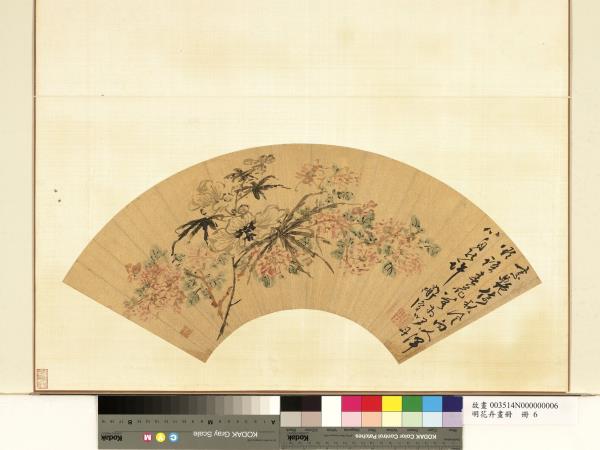| 文物統一編號 |
故畫003514N000000006
|
| 作品號 |
故畫00351400006 |
| 品名 |
明花卉畫冊 冊 明陳淳花卉
Hibiscus and Crape Myrtle |
| 分類 |
繪畫 |
| 作者 |
陳淳 |
| 數量 |
一幅 |
| 題跋類別 |
作者 |
位置 |
款識 |
書體 |
全文 |
| 作者款識 |
陳淳
印記 expand_more
|
本幅 |
素艷倚秋風。向人渾歌語。春花莫為笑。丹心自能許。道復。 |
草書 |
|
|
|
| 主題類別 |
主題(第一層) |
主題(第二層) |
主題說明 |
| 主要主題 |
花草 |
秋葵 |
|
| 主要主題 |
花草 |
紫薇 |
|
| 類別 |
參考資料 |
| 內容簡介 |
陳淳(西元一四八三-一五四四年),江蘇長洲人。字道復,又字復甫,號白陽山人。精於經學、詩文、書法、篆籀。好畫事,曾師事文徵明,善作米家山水,更善於寫意花卉,才氣縱橫,不拘於師門。王世貞評其花鳥畫與沈周、徐渭、周之冕並立為明代四大家
本幅用金箋,墨色畫秋葵,極為突出,而紫薇花退居為背景,層次分明。畫中用筆,如不經意,卻是寫意畫,求其意到而已。
本幅為花卉畫冊第六幅。
|
| 內容簡介 |
陳淳(西元一四八三-一五四四年),江蘇長洲人。字道復,號白陽山人。生性穎悟,天才秀發,凡經學、古文、詞章、書法、繪畫,咸臻其妙。曾遊學文徵明門,徵明僅謙稱是他的舉業師,而不敢以書畫師自居。
陳淳畫花卉以水墨寫意見長,筆簡意全,前人批評為「一花半葉,淡墨欹豪,疏斜歷亂之致,咄咄逼真。」此幅畫折枝秋葵和紫薇,一水墨,一設色,勾花點葉全以書法入畫,草草似不經意,而能得其生動自然的意趣。
本幅為「花卉畫冊」第六開。
|
| 內容簡介 |
陳淳(1483-1544),字道復,又字復甫,號白陽山人。江蘇長洲人。繪事曾師文徵明,善作米家山水,尤以寫意花卉聞名。
本幅選自<明花卉畫冊>,採用金箋,以扇面形式構圖,描繪折枝秋葵和紫薇,一水墨,一設色,頗有特色。沒骨法寫秋葵,花朵兼顧側仰面,另加乾渴筆繪葉,葉面破損折裂。紫薇花以洋紅加赭石寫花瓣,葉片橢圓對生,以花青加藤黃少許設色。此幅鉤花點葉筆簡意全,草草似不經意,卻能得其自然意趣。(20110102)
|
| Description |
Chen Chun (style names Daofu and Fufu; sobriquet Baiyang shanren) was a native of Changzhou in Jiangsu. In painting, he studied from the master Wen Zhengming, excelling at landscapes in the “Mi” family style and achieving particular fame in flowers done in the “sketching ideas” manner.
This leaf from “Album of Ming Flower Paintings” is done on gold-flecked paper, the composition following the format of the original folding fan. It depicts branches of hibiscus and crape myrtle, one in ink and the other in colors, making for an unusual painting. In the “boneless” wash method for the hibiscus, the artist gave consideration to different angles of the blossoms. Also, the dry brushwork for the leaves reveals them to be broken and split. The crape myrtle blossoms were depicted in magenta with ochre for the petals, the opposing leaves oval in shape and done in cyanine blue with gamboges yellow to give them some color. The rendering of the leaves and blossoms here is succinct yet complete, cursive but not careless, being quite capable of expressing naturalness.(20110102)
|
| Description |
Ch’en Ch’un (style name Tao-fu; sobriquet Pai-yang shan-jen) was a native of Ch’ang-chou, Kiangsu. He was a versatile genius, for all of his Classical studies, classical prose, poetry, and works of calligraphy and paintings were marvelous. He once went to study under Wen Cheng-ming (1470-1559), who only humbly admitted to being Ch’en’s “primary school” teacher and did not dare to consider himself Ch’en’s instructor of painting and calligraphy.
Ch’en Ch’un’s flower apintings are often rendered by means of the “sketching ideas” method in monochrome ink. Even though his brushwork is abbreviated, the forms are complete. Previous critics, commenting on Ch’en’s works, have said, “[His paintings of] a flower and half a leaf are done magnificently using light ink. Though extremely sparse and [apparently] chaotic [in brushwork], the forms still have an overwhelming life-likeness.”
In this album leaf, the sunflower plant and wisteria were done in monochrome ink with color. The outlined flowers and dotted leaves were entirely executed with calligraphic brushwork. They are so cursively rendered as to appear to have gone beyond the idea of the forms, thus acquiring the very idea of animated naturalness.
|
| Description |
Ch’en Ch’un (style name Tao-fu and Fu-fu; sobriquet Po-yang shan-jen) was a native of Ch’ang-chou, Kiangsu. A skilled poet and calligrapher, he was also an accomplished painter. He studied under Wen Cheng-ming (1470-1559) and excelled in creating misty landscapes in the Mi tradition. He often painted in a highly abstract manner, rendering flowers in the “sketching ideas” manner. Ch’en was a talented, innovative artist who was not conservative in his approach to painting. Wang Shih-chen onced commented that, in bird-and-flower painting, Ch’en Ch’un ranks with Shen Chou, Hsu Wei and Chou Chih-mien as one of the Four Great Masters of the Ming dynasty in this genre.
Painted on the golden paper of a folding fan mounted as an album leaf is a depiction in monochrome ink of hibiscus blossoms in autumn seeming to jump from the surface. The violet blossoms behind appear to fade into the background to create a layered effect. Although the use of the brush appears sketchy, the artist has managed to capture the essence of these autumn blossoms with a minimum of brush strokes and ink washes.
|
| 參考書目 |
1.〈明花卉畫冊 冊 明陳淳花卉〉,收入譚怡令、劉芳如、林莉娜主編《滿庭芳-歷代花卉名品特展》(臺北:國立故宮博物院,2010年十二月初版一刷),頁112-113。
|
| 收藏著錄 |
故宮書畫圖錄,第三十冊,頁132-135
|
| 收藏著錄 |
故宮書畫錄(卷八),第四冊,頁163
|
本院文物保存維護依〈國立故宮博物院典藏文物管理作業要點〉及〈國立故宮博物院文物修護業務作業原則〉辦理
抽盤點紀錄
修護紀錄










